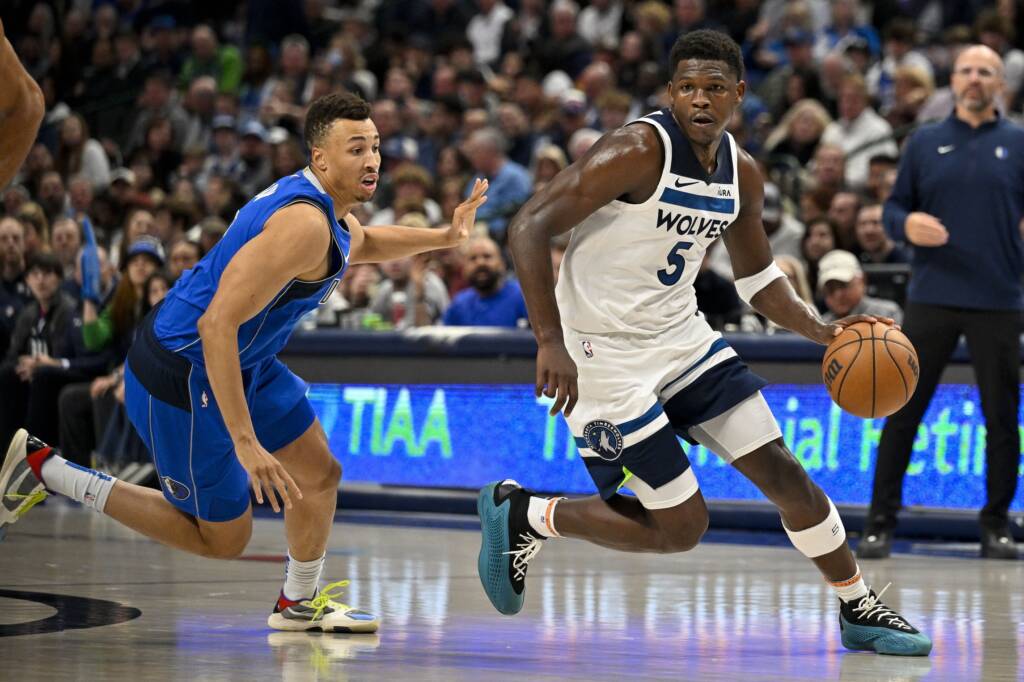Anthony Edwards returned to the lineup Thursday night in Dallas after missing an additional game due to re-aggravating a hip pointer. He had missed three games before that. Edwards came back with enough rust that a used car dealer couldn’t push it off as the paint chipping. Edwards shot 3 of 19 from the field and had 5 turnovers. Despite that, he was crucial in making the offense flow and made his presence felt.
Edwards played 35 mins in an impressive 18-point win over the Mavs and finished with a team-high plus-20 in overall plus-minus. That could be in large part to Naz Reid’s stellar 27-point night. However, it’s much more related to Edwards’s ability to make the offense hum despite not making shots.
Digging into Edwards’ plus-minus, one particularly impressive thing is that he finished with a team-high plus-20 while also being on the floor for Minnesota’s abysmal 17-2 start to the game. Finishing plus-20 after falling behind 15 within the first 6 minutes of the game essentially means that Edwards finished plus-35 after the slow start.
Edwards’ game shines when we look more into the advanced stats. He finished with a team-high 10 assists, most came off of Edwards’ drives where defenders sagged in to help defend him around the rim. On multiple occasions, Edwards recognized players sagging in and found the open man for easy wide-open threes. Below is Edwards doing his best Doncic impression by drawing in nearly the entire Mavs team before kicking to Nickeil Alexander-Walker for a corner three.
It was interesting watching him lure and draw additional defenders to help guard him, especially against Dallas. Luka Doncic is perhaps the best player in the league at luring help defenders into poor positioning. The Mavericks lead the league in corner three-point volume, primarily because of Doncic’s ability. Seeing Edwards pull defenders in his direction and recognize what defender is out of position before passing the ball to the corners is a massive leap in his development, and seeing him do this against the league’s best at this tactic was fun.
Edwards had 10 assists. Six were on 3-point field goals, including a couple where Edwards attacked the basket and created the opening for his teammate off of pick-and-rolls. Edwards has shown that he understands the preferences of each of Minnesota’s centers.
We can see that by how he makes reads off the pick-and-roll with different players. Consider the contrast between Rudy Gobert and Naz Reid. Looking back to the Spurs showdown on December 6. Edwards and Gobert finish on a pick-and-roll that Edwards has increasingly been attempting to run. On this play, Edwards quickly dribbles around Gobert to lure center Victor Wembanyama out to the mid-range. Malaki Branham follows Edwards, knowing he can pull up from the mid-range or do a step-back three.
Simultaneously, Wembanyana scrambles back in front of Edwards to try to stop the drive. Meanwhile, Gobert spins around and receives an on-point pass for an easy dunk.
Thursday night in Dallas, Edwards runs the same setup with Naz Reid. Edwards accepts the pick-and-roll and quickly dribbles around it, drawing Dereck Lively to crawl up to defend the screen and forcing the screened defender to scramble to defend against the pull-up or step back. The defense is similar to the Gobert play. However, Reid is much better at shooting the three or driving in space. Edwards recognizes this and bounces the pass to him for an open three. Look at the clips below for contrast.
This understanding of player preferences may seem trivial. But it’s critical to run similar actions in the heat of a game and trust that your teammate will recognize the same defenses. Edwards can recognize an opportunity without any verbal acknowledgement and know that Gobert understands to hard roll off the screen and expect a lob.
In contrast, Naz recognizes the need to fade due to the hedge by the defender for the open three. Both centers must trust that Edwards will see them and read and react without communication. To Edwards’ credit, he has grown immensely in his ability to read the defense and “see” his teammates. Edwards joked last season he has “never thrown a lob.” But he’s shown an impressive ability to toggle what he needs to do based on his teammates’ abilities and preferences this season.
On the defensive side of the ball, Edwards again made an impact. Staying engaged throughout the game, Edwards held opponents to 5 of 15 shooting against him, including 0 for 7 from three. However, the Wolves mainly used Edwards in a secondary defensive role, meaning he rarely was the primary ball handler on Doncic.
That allowed Edwards to essentially play free safety and lurk in passing lanes. It should also be noted Edwards finished with two steals. Edwards was up to the task of guarding Doncic, though. He matched Doncic’s jerky style with his own ability to recover due to his athleticism.
The clip below highlights the benefits of having Edwards as a roaming defender. Edwards lurks in the passing lane and intercepts an arrant pass from Doncic, then pushes the pass and starts the break instantly. Edwards has developed the ability to make better reads in transition, ending in a Reid three.
Edwards has returned. His offense looks significantly less clunky, and his defense remains engaged. Edwards showed that although the Wolves had a winning record without him, the team is significantly better off when he is playing. In the clip below, Edwards hits Conley on the corner for a dagger three to topple Doncic and bounce back from a tough Pelicans loss.
Edwards is proving that he is taking the next step to superstardom. Whether his jump shot is falling or getting calls from the referees, Edwards shows that he understands how much attention he draws from a defense. Most importantly, Edwards understands that trusting his teammates leads to success.

